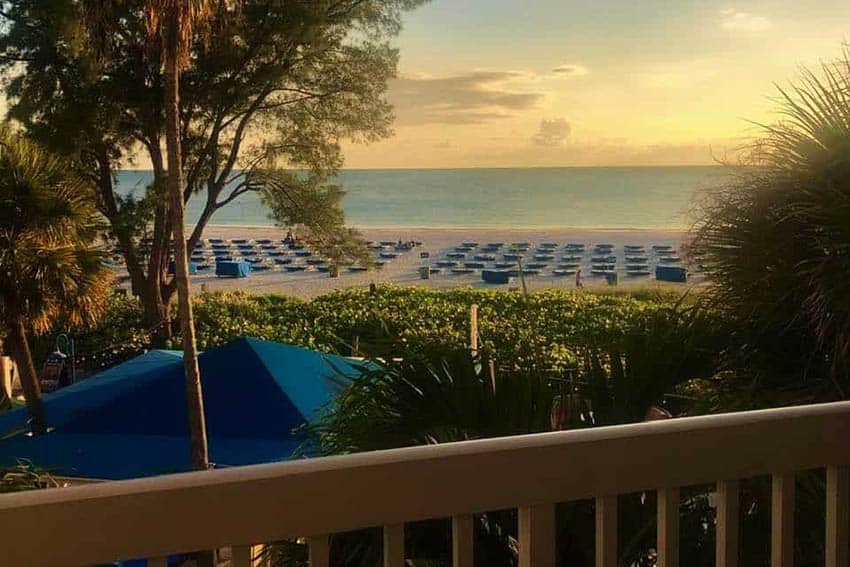
New Orleans According to “Treme”
The new HBO Series is a perfect way to get to know the Post-Katrina Crescent City
By Ann Banks
It’s 7 o’clock on Tuesday night, the official start time for jazz trumpeter Kermit Ruffins’ regular gig at Bullet’s Sports Bar.
Bullet’s is an unassuming hangout on a street of bungalows in New Orleans’ Seventh Ward. Out on the sidewalk grillmaster Bingo is barbequing ribs ($10 a plate, with sides).
“The best ribs in New Orleans” Ruffins declares from the front of the room, a generous endorsement since he’s known for hauling his own grill to gigs and feeding the crowd between sets.
Like New Orleans itself, Kermit, as everyone calls him, is both charismatic and supremely casual. Tonight he’s wearing madras plaid patchwork pants, an white shirt over a white T-shirt, and a black fedora with a yellow pencil stub tucked behind his ear.
Ruffins is ready to pick up his horn, but the bass player is nowhere to be seen. “When he walks in, everybody give him a big hand,” Kermit tells the crowd.
The place has been packed for an hour, except for a few tables in front with signs declaring that they are reserved for “Treme.” That would be “Treme,” the new HBO television series whose ten-episode season is scheduled to start on April 11th.

The show is produced by Eric Overmeyer, an ex “Law and Order” writer who lives in New Orleans and David Simon, creator of “The Wire,” the riveting, critically acclaimed five-season saga of Simon’s hometown Baltimore.
“Treme” explores the lives of musicians, chefs and other New Orleanians struggling to rebuild their lives and reclaim their culture after Hurricane Katrina.
It is David Simon’s mantra, recited often in interviews, that New Orleans’ singular culture is what is bringing the city back, “one second-line parade at a time, one crawfish etouffee at a time…” And, you might justifiably add, one trumpet solo at a time.
All the music in “Treme” is recorded live on the set and several scenes have been filmed here at Bullet’s, described by one of the show’s characters as “the real New Orleans.” Simon, a long-time fan of New Orleans music, hired local legend Ruffins, first as a consultant, and then as an actor playing himself.

But the half-dozen “Treme” crew members who’ll fill the front tables tonight are on a busman’s holiday – they’re coming just to hear Kermit blow his horn. (Ruffins can be heard elsewhere around town, including a regular Thursday gig at Vaughan’s, another “Treme” location. That one starts later and attracts more out-of-town visitors.)
As a passionate fan of both “The Wire” and New Orleans, I have come to town to follow the “Treme” trail of breadcrumbs — to hear the music, eat the food and witness the traditional jazz and brass-band parades that the series will celebrate.
My high expectations are shared by many New Orleanians, who hope “Treme” will become an advertisement for the city and help restore tourism to pre-Katrina levels. (It’s now at about 70 percent.)
Of course “Treme” is not meant as a travelogue, but Simon has gone to great lengths to capture the spirit of the city. He revels in its complex traditions, from social and pleasure club parades to Mardi Gras Indians to jazz funerals, all of which are lovingly depicted. Kermit Ruffins is only one of several dozen local musicians who perform in “Treme.” Music supervisor Blake Leyh hopes that the series will “introduce this incredible music to a larger audience.”
HBO has been keeping a tight lid on plot specifics, but there are plenty of tip-offs to “Treme” locations. Local blogs report on the shooting schedule and the New Orleans Times-Picayune’s lively TV critic Dave Walker runs “Treme homework assignments,” complete with reading and listening lists, to prepare viewers for what they will see on the show.
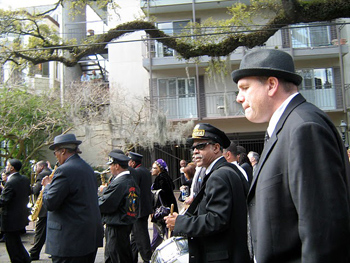
All Things “Treme”
My own introduction to things “Treme” comes from a writer on the series, Lolis Eric Elie. A former Times-Picayune columnist, Elie also wrote and co-directed (with Dawn Logsdon) a documentary called “Faubourg Treme: The Untold Story of Black New Orleans.
He explains that, while “Treme” is about all of New Orleans, from the 9th Ward to the Garden District, its name is taken from the neighborhood of Treme (pronounced Tre-MAY), near the French Quarter.
Considered the oldest African-American neighborhood in America, Treme has nurtured generations of jazz musicians. It is, as David Simon has said, where New Orleans gave birth to itself.
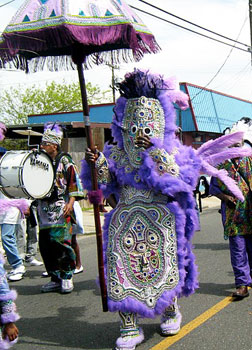
Lolis and I meet up at the Candlelight Lounge to hear the Treme Brass Band, a traditional marching band that appears at the end of episode 1 playing “Just a Closer Walk with Thee” in a funeral parade. According to Jazz Times, it’s the band to call “when folks want to honor a musician… with a traditional jazz funeral.”
Indeed, two days later, I will see the band in the real funeral parade of drummer Bernard “Bunchy” Johnson, who appears with the Treme Brass Band in the show; the mourners include Simon, Wendell Pierce and others from the cast and crew.
But there are no dirges on Wednesday at the Candlelight, the regular night the band plays. It has to be one of the friendliest scenes in town. The music is free and so are the red beans and rice.
The audience is mixed-race and multi-generational. Many well-known New Orleans musicians got their start with the Treme Brass Band and return to sit in with co-founders Benny Jones and the irrepressible and famously dapper Lionel Batiste, known throughout the city as “Uncle Lionel.” Trumpeter James Andrews is a star soloist and the brother of Troy Andrews, a.k.a. Trombone Shorty, who’s also featured in “Treme.”
After music, New Orleans expresses its personality through food. It’s a high-fat town. “We love bold flavors,” says chef Susan Spicer, co-owner of Bayona, one of New Orleans best restaurants. “We love our pork products and our fried things.”
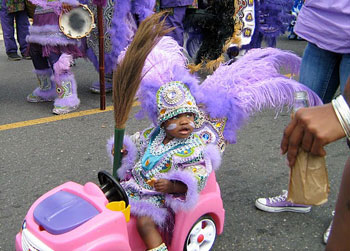
Spicer is the Kermit Ruffins of the restaurant world, a beloved local icon with a growing national reputation. Like Ruffins, she was a “Treme” consultant and is the model for one of the characters, a young chef named Janette Desautel who struggles to reopen her restaurant after the storm. Susan Spicer is older than the fictional Desautel and her French Quarter restaurant is more high-end.
Even so, the price tag on Bayona’s fine dining is quite reasonable. On the day I visit, nothing on the lunch menu costs more than $15.
I follow friends’ recommendations and order what they promise are menu stand-outs: roasted garlic soup and a sandwich of cashew butter, roast duck and pepper jelly. It’s a rich combination, but both dishes are as delicious as promised.
To track down another “Treme” restaurant, I follow a clue from David Simon himself, who tells listeners at a local literary festival about his consternation at misrepresenting local landmark Liuzza’s by the Track…..something about portraying it as not having Abita beer on tap when it really does.
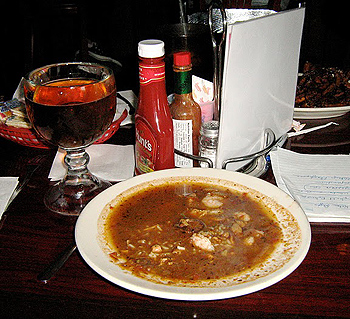
Or the other way around. There are two Liuzza’s in town. Liuzza’s by the Track (so named because it’s near the racetrack and fairground), on North Lopez Street, is where Creighton Burnette, the character played by John Goodman, orders a bowl of gumbo.
Liuzza’s is “the quintessential neighborhood joint,” according to its own website. Abram Himmelstein, founder of the Neighborhood Story Project and my lunch companion, agrees. This is his favorite haunt; he has described it in print as, “On its best days… the best-catered community center in America. On lesser days… the restaurant with the best gumbo in America.”
I can believe this, because it’s certainly the best gumbo I’ve ever tasted — thinner than most New Orleans gumbo, but packed with powerful and distinct flavors. Chef and co-owner Billy Gruber credits the recipe to his mother and says the secret is in the blackness of his roux, the traditional flour and fat base, “as black as the ace of spades.”
Gumbo has long been the go-to metaphor for New Orleans, easy shorthand for its idiosyncratic blending of cultures, classes, ethnicities and musical styles. Now, in the form of “dramatic gumbo,” the comparison is popping up in early reviews of “Treme.” And why not, if the cliché fits? As long as it’s Liuzza’s gumbo, the kind Billy Gruber’s mother used to make.
More on Treme
For current music and restaurant listings in New Orleans, check Gambit Weekly”s Best of New Orleans blog and the New Orleans Times-Picayune Nola.com.
Scenes at “Treme’s” Desautel were shot at Patois, a bistro in the Uptown neighborhood that Men’s Journal included in its list of the five best restaurants to open in New Orleans after Katrina.
Its Sunday brunch is especially popular.The small, fascinating Backstreet Cultural Museum is the place to learn more about Treme, African-American Mardi Gras Indians, and the Social Aid and Pleasure Club and Jazz Funeral traditions. Become a member of the museum, and you will receive regular emails announcing the upcoming times and routes of the Social Aid and Pleasure Club second line parades.
The beautiful French Quarter Hotel Monteleone is an official Literary Landmark, one of three so designated by the Friends of Libraries, USA. Its guests have included noteworthy authors from William Falukner to Eudora Welty – as well as the “Treme” writing staff, which hashed out plot points in one of its elegant suites overlooking the Mississippi River.
 Ann Banks, shown here in Sicily, is a journalist based in New York. Her travel writing has appeared in Conde Nast Traveler, The New York Times, and Arthur Frommer Budget Travel, among other magazines. She is a contributing writer for the Travel Intelligence website. Read more of her stories at her GoNOMAD Author page.
Ann Banks, shown here in Sicily, is a journalist based in New York. Her travel writing has appeared in Conde Nast Traveler, The New York Times, and Arthur Frommer Budget Travel, among other magazines. She is a contributing writer for the Travel Intelligence website. Read more of her stories at her GoNOMAD Author page.
- Venice on a Kayak - November 23, 2022
- Le Marche, A Great Place to Paddle - January 1, 2018
- Carriacou, Speaking Words of Shakespeare - May 29, 2016





